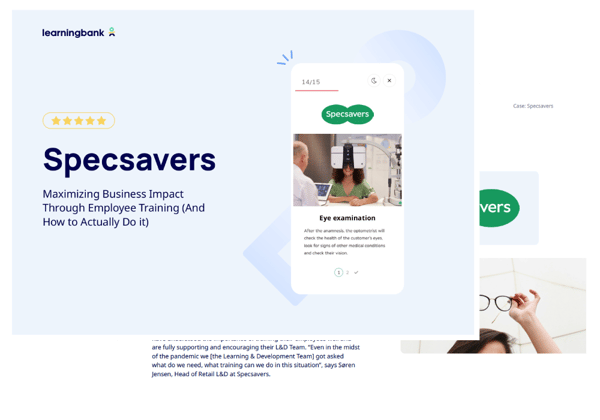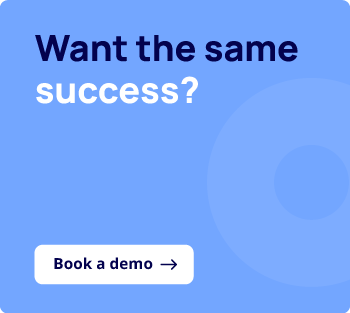


How to Maximize Business Impact Through Employee Training
| Industry: Retail | |
| Size: 41,500 Employees |
|
🏆Awardwinning Learning & Development
In November 2025, Specsavers Northern Europe was recognized on the global stage at the International Customer Experience Awards. Their strong commitment to people development and high-quality learning earned them Bronze for Best Learning & Development (Over 5000 Employees). This recognition highlights the learning culture they continue to build — one that strengthens skills and supports performance across their teams.
They also took home Gold for Best Measurement in CX (Over 5000 Employees), a testament to their strong work with customer experience insights and their focus on continuous improvement across the organization.
|
At Specsavers, Learning & Development (L&D) is a priority at all times. The management has understood the importance of training their employees well and is fully supporting their L&D Team. “Even in the midst of the pandemic, we [the Learning & Development Team] got asked what do we need, what training can we do in this situation,” says Søren Jensen, Head of Retail L&D at Specsaver.
How come L&D is such a priority for Specsavers? Søren explains why:
“We have a passion for developing people. This ensures our employees' commitment and motivation, giving us a lower staff turnover, which means more stability and ultimately gives us happier customers. If we do not train our employees well, they will be a liability to the business. And that, we cannot afford to risk.”
| Søren Jensen, Head of Retail L&D at Specsavers |
| About Specsavers: Specsavers is one of the world's largest optical chains. Founded in 1984 by optician couple Doug and Mary Perkins in England, they now have 2615 stores in 11 countries with approximately 41,500 employees. Learningbank is currently used in Specsavers Northern Europe & Canada. |
L&D: A Long-Term Play for Big Wins
L&D is not a quick fix. Unfortunately, one training day or session will not crack the nut. Behavior change takes time, and effective training requires consistent reinforcement. And as Søren reminds us, “We’re talking about behavioral changes here, and those changes won’t happen overnight.”
For those restless people out there, we’re sorry, but even the research shows that it can take between between 18-254 days to change behavior and habits.
New behaviors need consistent reminders and reinforcement to become ingrained to produce those tangible results you’re looking for. So don’t give up if you don’t see any results right after you implement your training.
Importance of Tracking Your
Training Initiatives
“We are a retail healthcare business, and because of that – failing is not an option! Untrained employees would lead to bad sales numbers, people would complain, and we would get a bad reputation. And those are all reasons why we need to get our employees trained as fast as possible.”
But how do you know that the training you create for your employees actually gives the impact that you are looking for? Well, by tracking it and looking at how it performs.
“Tracking progress is crucial to ensure behavior change and optimize the impact of training.” And the possibility of getting good data and analytics directly from the platform is one of the reasons why Specsavers chose Learningbank. Søren continues:
“With Learningbank, we get what we need. We can see completion rates & ratings of trainings and we can make the training personal. Both are vital things to be able to see the impact with training. Plus, it’s easy to use, we easily get the data from the analytics part in the platform.“
Take a quick tour of the Analytics feature in the platform that Specsavers are using to find the data they need. 👇
“We need to make training so good that our employees want to take it. That’s when it has the best outcomes”
Søren says and continues, “Currently our aim is 85-90% of completion rate for our onboarding for example, which we believe is good.” He explains that if people complete their training, they are more likely to see a change in behavior aligned with their goals. And to keep an eye on this you need to track your training!
With Learningbank, Specsavers track their training, and to make the comparison easier, they connect it to Power BI, making it easier to compare and see the impact of their L&D and how it relates to their Sales KPIs and Customer Satisfaction.
Connecting The Dots From a Retail Perspective
“For us as a business, we have a strong focus on customer loyalty. We look at the volume of loyal customers rather than a huge AVC.” (AVC= The average variable cost.)
So how do you translate the business metric of customer loyalty into L&D? Well, Specsavers provide their staff with training to deliver exceptional service and product expertise to reach and improve customer loyalty.
“We need to train our employees to ensure our business metrics. We need to train our employees well so they know how to treat our customers, how to use the machines and have good knowledge of our products. That way we reduce unsatisfied customers, reduce customers returning purchases etc.”
In other words, this is where to align your learning strategy with your business goals.
Product Training for Customer Loyalty
One vital training to support customer loyalty for Specsavers’ store employees is product training. To ensure employees know how to fit lenses correctly to the individual customer, they get specific product training in how to use the advanced measuring tools.
This is important because if not handled correctly, it will have a huge impact on how customers perceive the service. But with proper training, they ensure that customers receive the right help and products, minimizing returns and complaints and instead: increasing customer loyalty.

Copy the Formula
Just like for Specsavers, customer loyalty is a key business metric for many retail businesses. So, let us stick with this as an example. Customer Loyalty can be addressed by, for example, providing targeted customer service training as part of your L&D strategy.
Picture this: you're launching a brand-new customer service training program, and your results are booming like a disco ball in the 70s! Customer loyalty is skyrocketing, and completion rates are through the roof. Bingo! You've hit the customer service bullseye!
But before you start popping champagne corks, let's rewind a bit.
Steps to Maximize Business Impact through Employee Training:
- Identify Your Mission: Think of your business objective. What's the ultimate outcome you desire? In this case, we're aiming for peak customer loyalty, a.k.a., the final hurdle! So, your business metric here is customer loyalty, which is the ultimate measure of retail success.
- Skill Gap Quest: It's time to set the strategic initiatives or actions you need to take. This could involve assessing your team's skills. Where are they now, and where do they need to be to reach that ultimate level of customer service excellence? This is your skill gap, and it's time to close it! To give an example, let's say you found out customer service was the missing link.
- Create the Right Training: Based on your skill gap assessment, craft your training program. In this case, it's customer service superhero training! Prepare to see capes and can-do attitudes flying around!
- Monitor Your Metrics: Keep your eye on the training completion rate. If it's low, it's time for some engagement activities to get everyone logged in and excited! L&D Metric: Completion Rate
- Continuous Improvement: If customer loyalty (your business metrics) doesn't budge? Don’t panic! Even superheroes need to refine their skills. Feedback and ratings is your friend. Use it to tweak and improve your training and get back on track. As Søren said, “Learning & Development is always the answer to improve your business results, no doubt about that”.
Bonus points: Got multiple stores? Compare them! See which stores with high completion rates also boast the highest customer loyalty. Now you have powerful ammunition to motivate the other stores.
Learningbank - The Perfect Fit for Spesavers
Specsavers use Learningbank's platform for its ease of use, insightful analytics, great support, and like-minded people.
“The people we met from Learningbank also played a role in the decision. It’s nice to work with someone who has the same dedication to L&D as we do.”
By aligning L&D with business goals, Specsavers demonstrates the magic of connected learning. Engaged employees with the right skills translate to happy customers and a thriving business.
Key Takeaways
- Learning & Development is vital for the business to thrive
- Aligning employee training to business goals drives business success
- Customer service & product training to increase customer loyalty in Retail
- High completion rates often give better & quicker results
- It takes time to see the results of L&D
- Tracking your L&D is a must to prove the impact & make effective training
Download the Full Case



